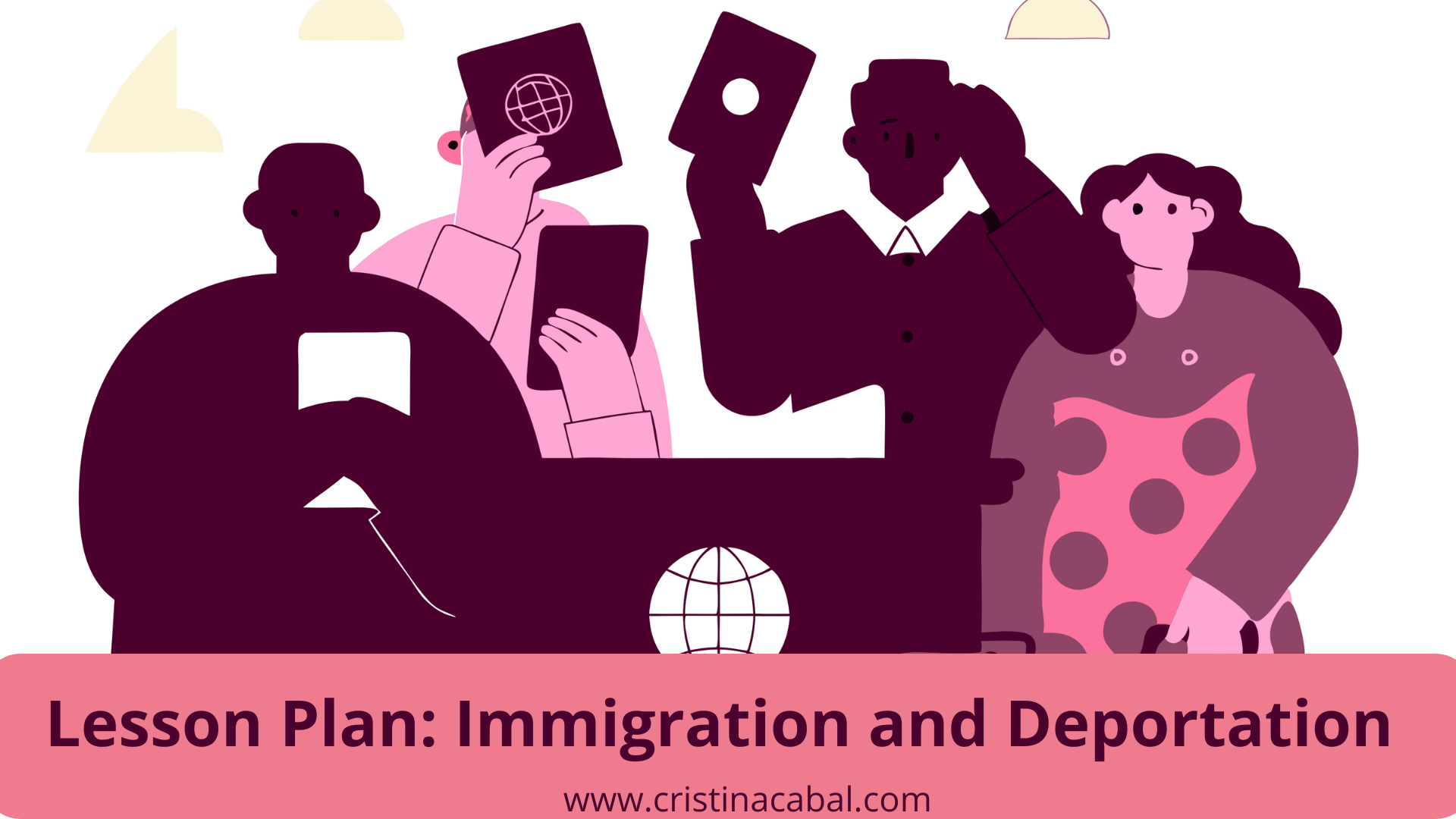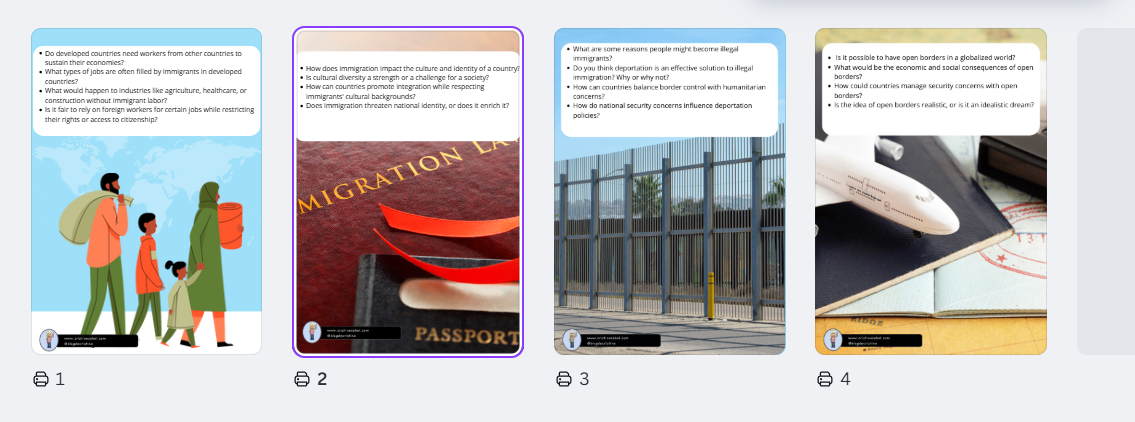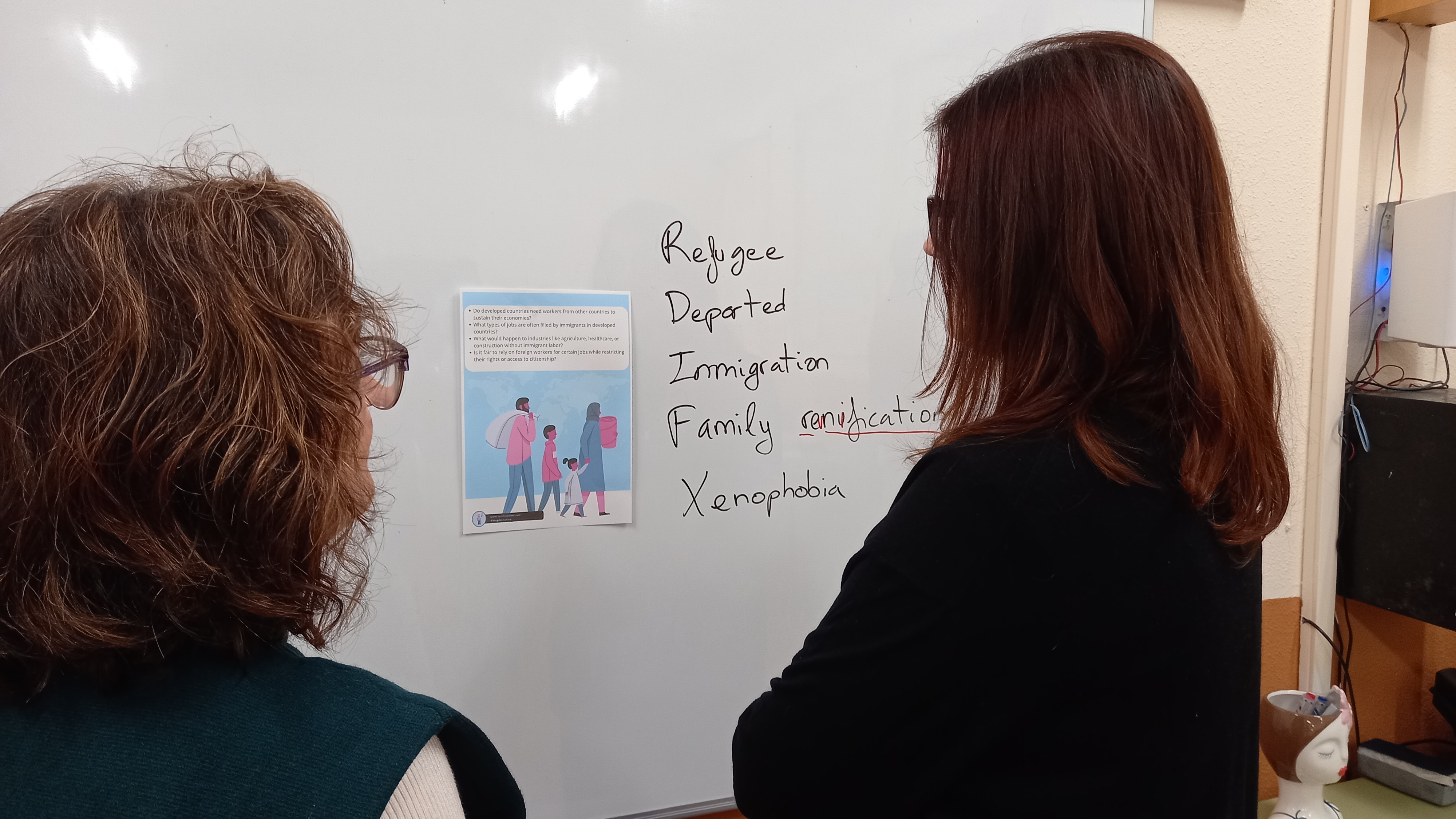Today, I want to share a lesson about a topic that affects real lives and stirs deep feelings: immigration and deportation. With recent events—like the thousands of deportations under Donald Trump’s policies—it’s clear that this issue is both timely and challenging. In this lesson, we’ll explore the language and ideas that help us discuss this subject respectfully and accurately.

What you will find in this lesson
- warm-up
- vocabulary
- speaking: gallery walks
- listening comprehension
Level:
C1 (Advanced)
Handouts
- Posters
- vocabulary and listening comprehension questions for the student and teacher’s answers.
WARM -UP
We will kick things off by drawing a mind map on the board. I will ask students to share any words or phrases that come to mind when they think about immigration and deportation.
What would you do if you had to leave your home country and start a new life somewhere else?
USEFUL VOCABULARY
Below is a list of useful vocabulary for discussing the topic of deportation and illegal immigration. This includes verbs, nouns, and phrases that will help students express themselves more precisely and fluently at a C1 level. I know the vocabulary list might seem a bit like a lot, but I’m pretty sure most of my students already know many of these terms.
SMALL CHALLENGE
Moreover, most of these words are super similar in their own language. So, what I’ll do is say the word in Spanish and challenge them to give me the English equivalent. This way, they’ll quickly see that they already know most of these terms and don’t need to stress about learning them all from scratch.
Verbs
- Deport: To forcibly remove someone from a country.
Example: “The government deported hundreds of illegal immigrants last year.” - Detain: To hold someone in custody, often while their legal status is determined.
Example: “Many immigrants are detained in centers near the border.” - Overstay: To remain in a country longer than the visa allows.
Example: “He overstayed his tourist visa and became an illegal immigrant.” - Flee: To leave a place quickly to escape danger.
Example: “Thousands of people flee their home countries due to war or persecution.” - Seek asylum: To request protection in another country due to danger in one’s home country.
Example: “She sought asylum after being persecuted for her political beliefs.” - Integrate: To become part of a community or society.
Example: “Successful integration programs help immigrants adapt to their new country.” - Enforce: To ensure compliance with laws or rules.
Example: “The government enforces strict immigration policies.” - Repatriate: To send someone back to their home country.
Example: “After the war, many refugees were repatriated.”
Nouns
- Immigration: The act of moving to a new country to live permanently.
Example: “Immigration policies vary widely between countries.” - Emigration: The act of leaving one’s country to live in another.
Example: “Emigration rates have increased due to economic instability.” - Refugee: A person forced to leave their country to escape war, persecution, or natural disaster.
Example: “Refugees often face dangerous journeys to reach safety.” - Visa: An official document allowing someone to enter or stay in a country for a specific purpose.
Example: “She applied for a student visa to study abroad.” - Citizenship: The status of being a legal member of a country.
Example: “He obtained citizenship after living in the country for five years.” - Border: The line separating two countries.
Example: “The border between the two countries is heavily guarded.” - Detention center: A facility where immigrants are held while their legal status is determined.
Example: “Conditions in some detention centers have been criticized by human rights groups.” - Humanitarian crisis: A situation where people suffer due to war, famine, or disaster.
Example: “The civil war has caused a humanitarian crisis in the region.” - Policy: A set of rules or guidelines adopted by a government or organization.
Example: “The new immigration policy has sparked widespread debate.” - Xenophobia: Fear or hatred of foreigners or strangers.
Example: “Xenophobia can lead to discrimination against immigrants.”
Useful Phrases and Expressions
- Illegal entry: Entering a country without proper authorization.
Example: “Illegal entry is often punished with deportation.” - Border security: Measures taken to protect a country’s borders.
Example: “Increased border security has reduced illegal crossings.” - Economic migrant: A person who moves to another country for better job opportunities.
Example: “Many economic migrants risk their lives to reach developed countries.” - Family reunification: The process of bringing family members together in one country.
Example: “Family reunification is a common reason for immigration.” - Human rights violations: Actions that abuse or deny basic human rights.
Example: “Deporting refugees to war zones may constitute human rights violations.” - Undocumented workers: People who work in a country without legal permission.
Example: “Undocumented workers often face exploitation.”
Speaking Activity 1: GALLERY WALK WITH POSTERS
I love using the gallery walk strategy. With this strategy I guarantee engagement, peer interaction and the possibility of listening to different perspectives. Here’s how I have done it in this lesson.
- Step 1. First, I help my students recall and bring forward newly learned vocabulary related to the topic.
- Step 2. Students pair up or form small groups of three. Together, they write down five vocabulary words related to the topic on a piece of paper. I then stick these around the classroom—I make sure to have as many groups as posters I have created.
- Step 3. Next, I put up posters on the walls, right next to each vocabulary sheet. Each poster contains questions related to the topic.
- Step 4. Now it’s time to move! Students get up, pick a poster with their group, and start answering the questions—making an effort to incorporate the vocabulary from the nearby sheet.
- Step 5. After about 5 minutes I give my students a signal to rotate to the next poster.
Click to see and print the posters with the questions.

LISTENING COMPREHENSION
In this video you will see a snapshot of recent events in the United States, focusing on the actions of the Trump administration.
Watch it and anwer the questions below
1.What is the implicit reason behind the deployment of US troops to the southern border?
- To offer humanitarian aid to migrants crossing the border.
- To prevent further entry of individuals into the United States
- To facilitate the processing of asylum seekers.
2.What can be inferred about the relationship between Trump’s administration and the processing of asylum seekers?
- The administration has streamlined the asylum process to efficiently manage the flow of migrants.
- The administration has halted the processing of asylum claims as part of its deportation strategy.
- The administration is providing additional resources to handle the increased number of asylum applications.
3.What is the primary intention behind Trump’s social media message to Russian President Vladimir Putin?
- To establish a collaborative partnership between the US and Russia.
- To express his solidarity with Russia and their actions in Ukraine.
- To compel Russia to stop the conflict in Ukraine by using threats of sanctions.
4.How does the video portray the views of Trump’s administration versus the views of those protesting border policies, such as those holding vigils and protesting in Las Vegas?
- Both groups are in agreement that current immigration policies are well-justified and humane.
- The groups are in direct opposition, with Trump’s administration initiating a hardline deportation operation and protesters resisting these measures
- The groups share a belief in the current laws but differ in their methods of supporting them.
5.What implication can be drawn from the information about Trump’s pardon of the Proud Boys leader, within the broader context of the video?
- It suggests a policy of leniency for all political offenders and those who have been convicted of violent crimes.
- It highlights a disregard for the legal process, particularly concerning those who were involved in actions that challenged the established government.
- It shows Trump’s preference for granting clemency to those who committed very minor crimes.
